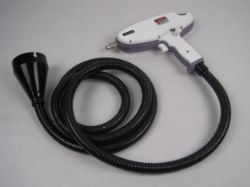Alaskan
0
- Joined
- Jan 29, 2014
- Messages
- 12,031
- Points
- 113
Please help with Lumenis Vasculight Laser Head Nd:YAG 1064nm
Lumenis Vasculight Laser Head Nd:YAG 1064nm
I bought a NOS 1064nm ND:YAG laser head without the power supply or control circuitry. Trying to find specs on the flash lamp and coolant flow required for this head as well as anything else that can be found about it. The manufacturer isn't helpful, tried already, they just want to sell me the newer version of this unit. The unit is capable of up to 50 joules of power, that's many thousands of watts of peak power.

Lumenis Vasculight Laser Head Nd:YAG 1064nm
I bought a NOS 1064nm ND:YAG laser head without the power supply or control circuitry. Trying to find specs on the flash lamp and coolant flow required for this head as well as anything else that can be found about it. The manufacturer isn't helpful, tried already, they just want to sell me the newer version of this unit. The unit is capable of up to 50 joules of power, that's many thousands of watts of peak power.

Last edited:





